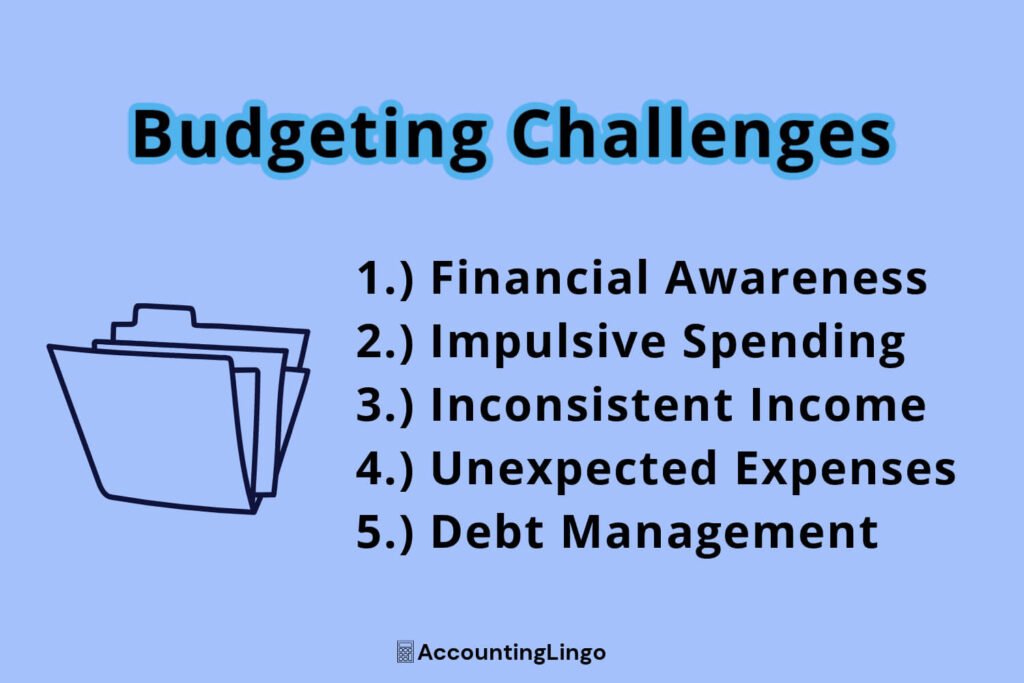
Budgeting is important for our financial well-being, but it can present many challenges. Overspending, unexpected expenses, and not knowing where to start can make it seem overwhelming.
This guide will review the top 5 challenges of budgeting and provide realistic solutions. We’ll supply tips on creating a budget and help you find ways to cut expenses without sacrificing quality of life.
Top 5 Budgeting Challenges
Budgeting challenges are often faced at various points in time. Identifying these challenges and implementing a realistic game plan to overcome them is essential.
By identifying and understanding common obstacles, you can develop strategies to move past these challenges, reducing financial anxiety along the way.
Challenge 1: Financial Awareness
What is budgeting? A common challenge for most individuals is needing to be more financially aware. Many people require guidance to keep track of their income, expenses, and overall financial picture.
Without fully understanding your financial situation, creating a workable budget, sticking to it, and making educated spending decisions is difficult. To overcome this challenge, begin with gathering financial documents like bank statements, credit card bills, and other items.
Take the time to clearly review and analyze your incoming and outgoing funds. This will give you a better picture of where your money is going and help you better understand areas needing improvement.
Next, create an Excel spreadsheet for budgeting or use free budgeting apps to track your income and expenses. Set realistic financial goals and allocate your income accordingly. It’s important to regularly review your budget and make adjustments when necessary.
By increasing your financial awareness, you will better understand your spending habits and be in a stronger position to make financial decisions.
Challenge 2: Impulsive Spending
Budgeting constraints commonly include impulsive spending, which can quickly derail financial goals. It’s easy getting caught up in the moment and making an impulsive purchase. However, impulsive purchases have a tendency to increase financial anxiety. It’s best to avoid these situations.
To overcome impulsive urges, practice mindful spending. Before making a purchase, ask yourself if it aligns with your financial goals. Is it something you truly need?
Implementing a waiting period before making non-essential purchases may be helpful. This gives give you time to evaluate the purchase and determine if it’s a wise financial decision.
Another effective strategy is to create a designated “fun money” category in your budget. This allows you to allocate a certain amount of money each month for discretionary spending. By permitting yourself to spend guilt-free within this category, you can satisfy your desire for spontaneity while staying within your budget.
Challenge 3: Inconsistent Income
Inconsistent income can make the practice of balanced budgeting a challenge. This is especially true for freelancers, entrepreneurs, or individuals with commission-based jobs. Planning and allocating your income is difficult when you don’t have a steady paycheck.
In these cases, it’s best to create a budget based on your average monthly income. Begin by tracking your income over a period of time to determine your average monthly inflow of funds. Furthermore, allocate your income into different categories like fixed expenses, variable expenses, savings, and debt repayment.
Building an emergency fund to cushion any income fluctuations is also essential. Saving three to six months of living expenses to provide a cushion during lean months is ideal. This helps you stay on track, especially when income is inconsistent.
Challenge 4: Unexpected Expenses
Unexpected expenses can derail even the most well-planned budget. From medical emergencies to car repairs, life is full of surprises that can strain your finances. However, you can overcome this challenge by being prepared and having a contingency plan.
Start by including a category in your budget specifically for unexpected expenses. Rope off a percentage of your monthly income to build a rainy-day account. These funds will act as a buffer when unexpected expenses arise, and they always do!
Lastly, review the insurance policies intended to protect you from major financial setbacks. Ensure you have and understand the basics of health insurance, car insurance, and home insurance.
Make sure your policies provide adequate coverage should an unexpected event occur. In addition, seek the advice of a qualified insurance professional when needed. They can help review and explain your coverages or lack thereof in detail.
Challenge 5: Debt Management
Debt is a common challenge many individuals face when it comes to budgeting. High-interest rates and monthly payments eat into a budget and hinder financial progress. However, with a thoughtful plan, you can overcome this challenge and live debt-free.
Start by prioritizing your debts. Identify which bills have the highest rate of interest and focus on paying those off first. In addition, strategically tackle debt using the debt avalanche or debt snowball method.
The debt avalanche strategy involves paying off debts with the highest interest rates first, while the debt snowball strategy suggests paying off the smallest debts first. Choose a plan that aligns best with your financial goals and motivates you to stick with the plan.
Negotiating with creditors to lower rates of interest or exploring debt consolidation options are also important to consider. By consolidating debts into a single loan with a lower interest rate, you may be able to simplify the repayment of debt and possibly save money in the long run.
Overcome Budgeting Challenges
Now that we have identified common budgeting challenges, let’s explore effective strategies to overcome them.
1. Realistic Budget
The first step is to create a realistic budget. Start by identifying your financial goals and align your budget with these goals. Furthermore, determine your income and allocate it into a budgeting category like fixed expenses, variable expenses, savings, and debt repayment.
Make sure to leave room for discretionary spending and unexpected expenses as well. Review your budget on a routine basis, such as monthly or quarterly, and make adjustments to your income or expenses when needed.
Creating a realistic budget that aligns with your goals provides you with a better financial roadmap to success.
2. Cut Expenses
Cutting costs doesn’t mean you must sacrifice quality of life. There are many ways to reduce expenses without the feeling of depriving ones-self. Start by analyzing your expenses and identifying areas where you can make cuts.
Look for subscriptions or services that you no longer use or can live without. Consider negotiating bills or switching to more cost-effective alternatives. In addition, focus on reducing discretionary spending. This may include eating out less frequently, strategically shopping for groceries, or enjoying free or low-cost entertainment.
Remember, small expenses add up over time and can significantly impact a budget as well as large expenses.
3. Automate Finances
Automating your finances help you stay on track with your budget and ensures bills are paid on time. Setup automatic transfers to your savings account and automate bill payments. This helps eliminate the risk of forgetting to pay and helps minimize overspending in certain areas.
Automating your finances also enables you to take advantage of savings strategies like setting up automatic contributions to retirement accounts or investment portfolios. You can build wealth over time by making saving a priority and automating the process.
Tools to Help with Budgeting Challenges
There are several tools to help make budgeting easier and more efficient. They can help you stay organized and on track with financial goals.
1. Budgeting Apps
Some of the best free budgeting apps like Mint, Honeydue, or Nerdwallet Money Tracker, can help simplify the budgeting process and provide a clear overview of your finances. These apps help track income and expenses, set financial goals, and receive personalized insights and recommendations.
2. Spreadsheet for Budgeting
If a more hands-on approach is preferred, you can use an Excel spreadsheet for budgeting to track your income and expenses manually. These spreadsheets can be customized to fit your specific needs and can provide a visual representation of your financial progress.
3. Financial Education Resources
Investing in your financial education is necessary for long-term success. Various resources exist like books, podcasts, and online courses, that can help improve your financial literacy. The greater your financial knowledge, the more informed you’ll be when making money-related decisions.
Professional Help for Budgeting Challenges
If you’re struggling to overcome budget-related challenges on your own, seek professional help. Financial advisors or certified financial planners can provide expert advice customized to fit your specific situation. They can help you create a personalized budget, develop a debt repayment plan, and supply advice regarding investment strategies.
Conclusion
By understanding and overcoming these common budgeting challenges, you can take control of your financial future. Budgeting is no longer overwhelming or stressful once you discover the right tools and begin proactively managing your financial life.
Additional Resources
Other helpful articles may include:
Debt Extinguishment: What is it?
What are Liabilities?
What is an Asset?
